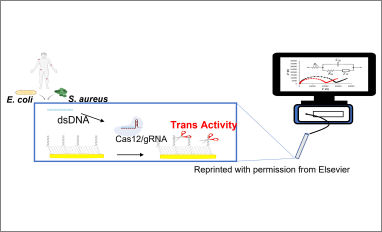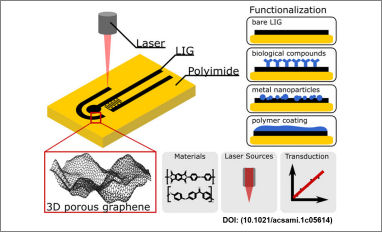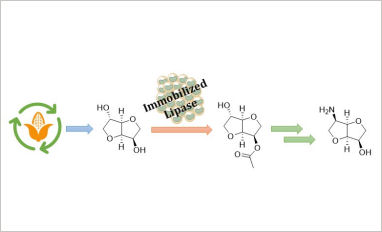
 Congratulations to our Ph.D. students Andrea Bonini, Noemi Poma and Federico Vivaldi from the Chemistry Lab for Analytical Technologies and Sensors (CATS), for their recent research article entitled "A label-free impedance biosensing assay based on CRISPR/Cas12a collateral activity for bacterial DNA detection". The rapid and selective identification in the clinical setting of pathogenic bacteria causing healthcare associated infections (HAIs) and in particular blood stream infections (BSIs) is a major challenge.
Congratulations to our Ph.D. students Andrea Bonini, Noemi Poma and Federico Vivaldi from the Chemistry Lab for Analytical Technologies and Sensors (CATS), for their recent research article entitled "A label-free impedance biosensing assay based on CRISPR/Cas12a collateral activity for bacterial DNA detection". The rapid and selective identification in the clinical setting of pathogenic bacteria causing healthcare associated infections (HAIs) and in particular blood stream infections (BSIs) is a major challenge.
 Congratulation to our PhD Mattia Bondanza for his publication on JPCL "Excited States of Xanthophylls Revisited: Toward the Simulation ofBiologically Relevant Systems". Xanthophylls are a class of oxygen-containing carotenoids, which play afundamental role in light-harvesting pigment−protein complexes and in many photoresponsive proteins. The complexity of the manifold of the electronic states and the large sensitivity to the environment still prevent a clear and coherent interpretation of their photophysics and photochemistry.
Congratulation to our PhD Mattia Bondanza for his publication on JPCL "Excited States of Xanthophylls Revisited: Toward the Simulation ofBiologically Relevant Systems". Xanthophylls are a class of oxygen-containing carotenoids, which play afundamental role in light-harvesting pigment−protein complexes and in many photoresponsive proteins. The complexity of the manifold of the electronic states and the large sensitivity to the environment still prevent a clear and coherent interpretation of their photophysics and photochemistry.
 Congratulations to our Ph.D. students Federico Vivaldi, Andrea Bonini and Noemi Poma from the Chemistry Lab for Analytical Technologies and Sensors (CATS), for their recent review entitled "Three-Dimensional (3D) Laser-Induced Graphene: Structure, Properties, and Application to Chemical Sensing". Notwithstanding its relatively recent discovery, graphene has gone through many evolution steps and inspired a multitude of applications in many fields, from electronics to life science.
Congratulations to our Ph.D. students Federico Vivaldi, Andrea Bonini and Noemi Poma from the Chemistry Lab for Analytical Technologies and Sensors (CATS), for their recent review entitled "Three-Dimensional (3D) Laser-Induced Graphene: Structure, Properties, and Application to Chemical Sensing". Notwithstanding its relatively recent discovery, graphene has gone through many evolution steps and inspired a multitude of applications in many fields, from electronics to life science.




